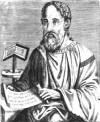



And I say unto you, that thou art Peter, and upon this rock I will build
my church; and the gates of hell shall not prevail against it
Matthew 16:18
When carefully examining the seven letters to the churches in Asia, one is presented with some intriguing questions. First, how was it possible for the church at Smyrna to suffer intense persecution (Rev. 2:10), while at the same time its sister congregation in Philadelphia was free to preach the gospel just a few miles away (Rev. 3:8)? Additionally, why are the churches in Thyatira, Sardis and Philadelphia identified as being in existence at the time of Christ’s return (Rev. 2:25, 3:3, 3:10-11) when these congregations have long since passed. The only reasonable conclusion is that the primary purpose of these letters is to describe church periods that were not contemporaneous. This fact is made even more clear when one considers the history of God’s people down through the ages and how that history dramatically reflects what is described in these seven messages.
The True History of the True Church
The unique content of these letters makes it clear that Jesus is addressing each church individually. In doing so, He first names the specific congregation after which He provides a brief description of it. He then presents a trait they need to work on, with the exception of Philadelphia. After doing so, Jesus identifies Himself as one who has also experienced trials but was faithful to the end (Rev. 3:21).
At this point, it is important to understand that both the name of the church and Christ’s personal description of Himself bear extraordinary meaning and relevance to each other. For example, the first letter is addressed to the church at Ephesus. The word Ephesus means "desired” and is a term that has a direct bearing on the message Christ gave to them. When speaking to this congregation, the Messiah offers words of encouragement (Rev. 2:2-3) as well as words of caution (verses 4-5). He then concludes this particular message with a great promise—if they repent and overcome, the Messiah will give them “the tree of life, which is in the midst of the paradise of God” (verse 7). It is clear by both the tone as well as the substance of this letter that Christ’s desire is toward this congregation. He deeply loves it and wants it to be a part of His eternal family.
A Great Story
As one carefully reads each of the letters to these churches it becomes clear that a great story is being unveiled about God’s people and how their history will play out. Before we explore this history consider what is revealed in these seven messages. The chart that follows represents a brief snapshot of each congregation (era) and their relationship to Christ and the message He brings them.
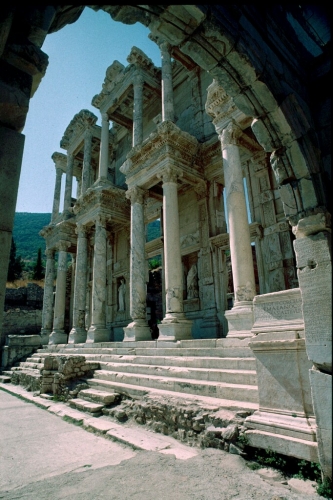
| Church Name | Meaning | A Church Trait | How Christ describes Himself | A lesson in the names |
| Ephesus |
The one desired | She lost her first love |
|
lose their love for God. Christ never loses His love for them. He is always with them and desires them |
| Smyrna |
Bitterness |
prison & death |
He rose from the Dead |
The Church suffers persecution and martyrdom, so Christ assures them that they are not the first to suffer, nor will they be the last. He rose from the dead and so will they |
| Pergamos |
Lifted up High |
such as idols & spiritual fornication |
He fights against them with His |
Christ will cut them down
|
| Thyatira |
Sacrifice |
Fearing to make the sacrifice, this Church tolerated Jezebel & committed spiritual fornication |
His feet are like burning brass. His eyes are like a flaming fire |
church, even consenting to be a part of it. Therefore, they become a fiery sacrifice--fire being a symbol of tribulation |
| Sardis |
Remnant |
|
He has the seven spirits and the seven stars |
has lost nothing |
| Philadelphia |
Brotherly Love |
They patiently keep God’s word |
He that is holy and true |
By keeping God’s word, they are judged to be holy and true. Jesus considers them His loving brothers
|
| Laodicea |
The People Judge |
A people fit for Christ’s judgment |
The faithful and true witness (martyr) |
|
A Tumultuous History
The story of God’s church down through the ages is one fraught with great challenges. This community of faith has struggled with severe apostasy from within and violent persecution from without. God’s people have experienced periods punctuated by a zeal to continue a great work as well as periods of complacency and indifference, where little or no work was being done. It has been a tumultuous history from its first step—and continues to be so to this very day. But throughout its story there emerges a profound lesson about God and how He will accomplish His purpose. The story begins with a church called Ephesus.
The First Era
The Church of Ephesus
"The One Desired"
31-100 AD

Ruins of Celsus Library in Ephesus
During the first century the church at Ephesus enjoyed the pastorate of two of God’s greatest New Testament servants—the apostle Paul and John, the brother of James, the son of Zebedee. Ephesus was the capital of proconsular Asia and was regarded as "the first and greatest metropolis of Asia. It was also home of the temple of Diana. The church in Ephesus was founded by the Apostle Paul (see Acts 18:19-21, 19:1-10). During his ministry he spent a total of about three years there.
When writing to the Church at Ephesus Christ expressed the following:
I know thy works, and thy labor, and thy patience, and how thou cannot bear them which are evil: and thou hast tried them which say they are apostles, and are not, and hast found them liars: And hast borne, and hast patience, and for my name's sake hast labored, and hast not fainted. Nevertheless I have somewhat against thee, because thou hast left thy first love. Remember therefore from whence thou art fallen, and repent, and do the first works; or else I will come unto thee quickly, and will remove thy candlestick out of his place, except thou repent. But this thou hast, that thou hatest the deeds of the Nicolaitans, which I also hate. He that hath an ear, let him hear what the Spirit saith unto the churches; To him that overcomes will I give to eat of the tree of life, which is in the midst of the paradise of God (Revelation 2:2-7).
Born in the first century, this era of God’s church reflected an excitement generated by their personal experience. They saw firsthand the miracles of the apostolic age. They were eyewitnesses to the spirit coming on Pentecost, and the tremendous growth of the early Christian church. At first they were on fire for God and took their calling seriously. However, as the years passed their faith and zeal was tested. They saw the infestation of false teaching and its influence on God's people and the world around them. They then witnessed the fall of Jerusalem and the destruction of the temple just as Jesus had predicted shortly before His death (Mt. 24:1-2).
In the wake of this devastation, those in Jerusalem fled to the mountains in accordance with the instructions Christ had given nearly forty years earlier (Lk. 21:20-21)—later settling in a place called Pella. The impact of this violence imposed migration was tremendous. God’s people had now lost the stability of a longstanding headquarters church in Jerusalem. Additionally, they experienced intense persecution from Rome. They watched as all the apostles, save for John, died violent deaths. Furthermore, although John was spared such an end, he too was the object of persecution. In 95 AD this apostle was taken prisoner by Emperor Domitian and banished to the island of Patmos.
The Nicolaitans
Although the church experienced an influx of false ministers, at first it resisted their doctrines. Chief among these heresies was a belief espoused by the Gnostic teacher Nicholas. Gnosticism is a term derived from the Greek word for "knowledge." The late John Ogwyn, in his work entitled God’s Church Through the Ages explained this belief and its impact on God’s people during the first century.
1949-2005
[Gnosticism] was a highly intellectual way of life. It represented a blending of Babylonian mystery religion, Greek philosophical speculation and an overlay of biblical terminology. Among the Gnostics, biblical accounts were not taken literally but were treated as allegories used to teach deeper "truths." Gnosticism stressed pagan dualism with its emphasis on the immortality of the soul and the inherent evil of matter. It also introduced much vain speculation on the nature of God and the spirit realm. Several New Testament books—including the Gospel of John, Colossians and 1 John—were written to refute the Gnostic heresies that Simon Magus and many others began to spread. (God’s Church Through the Ages)
As was mentioned earlier, one of the “many others” referred to by Mr. Ogwyn, was a man named Nicholas. Little is known about him, but it is clear that even God saw his deeds as despicable (Rev. 2:6). Some believe he was one of the first deacons ordained in the church (Acts 6:5), and that he later became influenced by the epicurean sect of the Gnostic teachers. It is certain however, that he was one of the first “antinomians,” and like other Gnostics, he taught that Christ was not really flesh and blood, as well as the time-worn lie that, as long as men had love in their heart, they could perform any kind of wicked deed, and it would not be imputed to them as sin. It was this sect the apostle John warned of in his first epistle. Notice his words.
Beloved, believe not every spirit, but try the spirits whether they are of God: because many false prophets are gone out into the world. Hereby know ye the Spirit of God: Every spirit that confesseth that Jesus Christ is come in the flesh is of God (I John 4:1-2)
While on Patmos, John could do little to combat some serious problems that began to emerge in the church, not the least of which was complacency. The zeal which had once defined this community of believers appeared to be slipping away and the excitement they once had for God’s truth was vastly different than it was at the beginning. In short, they had lost their first love.
The End of an Era
History records that sometime after the death of Emperor Domitian, John was released from Patmos and allowed to return to his home in Ephesus. The famous church historian, Eusebius wrote of this.
263-339
After fifteen years of Domitian's rule, Nerva succeeded to the throne. By vote of the Roman Senate Domition's honours were removed, and those unjustly banished returned to their homes and had their property restored to them. This is noted by the chroniclers of the period. At that time too the apostle John, after his exile on the island, resumed residence at Ephesus, as early Christian tradition records (Church History, p.127)
It is ironic that John served God’s people for the remainder of his life from Ephesus. But there is more than mere irony in this truth. It is from this very city that an era in the history of God's church would come to a close—an era in which Jesus’ original apostles would be the instruments He would use to forge a great work. John was the last of these faithful servants. However, his ministry was not the end of the work. As the book of Revelation clearly states, there were other cities and other letters.
The Age of Shadows
The Christian church during the end of the first century was considerably different from the one raised up by Christ under the leadership of Peter and John, and later, Paul. The noted Protestant historian, Jesse Lyman Hurlbut (1843-1930) describes it this way.
We name the last generation of the first century, from 68 to 100 A.D., “The Age of Shadows,” partly because the gloom of the persecution was over the church; but more especially because of all periods in history, it is the one about which we know the least... for fifty years after St. Paul's life a curtain hangs over the church, through which we strive vainly to look; and when at last it rises, about 120 A.D. with the writings of the earliest church-fathers, we find a church in many aspects very different from that in the days of St. Peter and St. Paul (The Story of the Christian Church).
Mr. Ogwyn also addressed this migration away from the original teaching of Christ and the apostles. He writes that what was once regarded as rank heresy by the founding fathers of God’s church eventually became a standard of “truth.”
The history of the Christian church between Pentecost of 31AD and the Council of Nicea in 325AD, almost 300 years later, is truly amazing. It is the story of how yesterday’s orthodoxy became today’s heresy, and how old heresies came to be considered orthodox Christian doctrine. It is the story of how church tradition and the teaching of bishops came to supersede the Word of God as a source of doctrine. (God’s Church Through the Ages)
However, despite the radical changes taking place in "professing" Christianity, God's true church continued to hold on to the truth as it moved into the pages of history. Its next chapter would be described in a letter written to the church in Smyrna.
The Second Era
The Church of Smyrna
"Bitterness"
100-450 AD
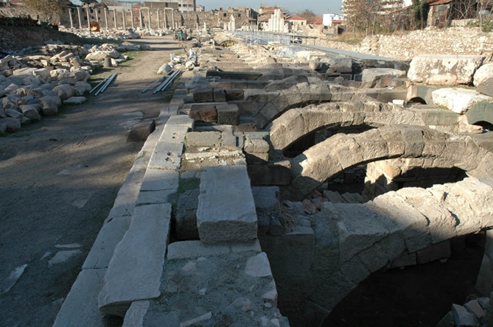
Ruins of Marketplace (Agora) in Smyrna
Although the apostle John had died, the church was not without leadership. Polycarp, a student of John’s, was ordained to carry on the work Christ commissioned His disciples to do. However, Polycarp would not lead this phase of the work from Ephesus as John had done. Instead, he would live and serve from the city of Smyrna. Eusebius wrote that Polycarp was ordained as the bishop of this city.
Pre-eminent at that time in Asia was a companion of the apostles, Polycarp, on whom the eyewitnesses and ministers of the Lord had conferred the episcopate of the church at Smyrna (Church History, p.145)
Polycarp was a true and faithful servant of God and dedicated his life to holding fast to the teachings of Christ and the original apostles. Mr Ogwyn observed that under his leadership the church continued to honor God's Sabbath and holy days.
As a young man, Polycarp had been a personal disciple of John and had observed the Passover with him on several occasions. Polycarp became prominent during the first couple of decades of the second century. The churches under his leadership remained one of the few areas where God’s Festivals continued to be observed throughout the remainder of the second century.
In his old age, Polycarp even made a journey to Rome seeking to convince the bishop of Rome, Anicetus, of his errors in not celebrating the biblical Passover date and in observing, in its place, an annual Sunday Paschal observance (Easter) and a weekly celebration of "Eucharist." (God’s Church Through the Ages)
History records that Polycard had to constantly deal with heresy that had crept into the church.
The steady progress of the heretical movement in spite of all opposition was a cause of deep sorrow to Polycarp, so that in the last years of his life the words were constantly on his lips, "Oh good God, to what times hast thou spared me, that I must suffer (tolerate) such things!" (Encyclopedia Britannica Eleventh Edition)
Under Polycarp, a new chapter in the history of God’s church would begin—one filled with great trials. The book of Revelation describes this period in a letter to the church at Smyrna. In it, Christ reveals that this era of His church would suffer both poverty and intense persecution.
Unto the angel of the church in Smyrna write; these things saith the first and the last, which was dead, and is alive; I know thy works, and tribulation, and poverty, (but thou art rich) and [I know] the blasphemy of them which say they are Jews, and are not, but [are] the synagogue of Satan (Rev. 2:8-9).
The word “Smyrna” means bitter, and certainly it was a bitter time for God’s people living during this period. First, they would experience great poverty. They were even referred to by the name, “Ebionite” meaning “paupers” or “poor people.” They were also called “Nazarenes,” and the beliefs of these early Christians is documented in the Encyclopedia Britannica.
They dated their settlement in Pella from the time of the flight of the Jewish Christians from Jerusalem, immediately before the siege in 70 A.D. . . . They recognized the new covenant as well as the old, and believed in the resurrection, and in the one God and His Son Jesus Christ. They used the Aramaic recession of the Gospel according to Matthew, which they called the Gospel to the Hebrews, but, while adhering as far as possible to the Mosaic economy as regarded circumcision, Sabbaths, foods and the like, they did not refuse to recognize the apostolicity of Paul or the rights of heathen Christians (Encyclopedia Britannica Eleventh Edition, p. 319).
Although these believers would endure great hardship it is clear that they respected God’s law. Because of this they would suffer intense persecution. Even Polycarp fell victim to this brutality. History records that he was burned alive by a mob in Smyrna. However, the greatest tribulation was yet to come and the letter to the church at Smyrna warned of its severity. It even predicted that many of God’s people living during this era would have to pay, with their lives, for the faith they held.
Fear none of those things which thou shalt suffer: behold, the devil shall cast [some] of you into prison that ye may be tried; and ye shall have tribulation ten days: be thou faithful unto death, and I will give thee a crown of life (Revelation 2:10).
Mr. Ogwyn describes this era of God's church as one which suffered great poverty. Additionally, it was the target of intense hostility from all corners of the Roman world.
Physically, the Christians of this era were impoverished and persecuted. They were rejected as heretics by the rapidly growing "Orthodox" movement, labeled as apostates from the synagogue by the Jews, and looked upon with contempt and suspicion by the surrounding pagan Roman society. In God’s estimation, however, those who remained faithful during this horrible time were accounted as having spiritual wealth of great value, and will ultimately receive a crown of life (Revelation 2:9–10). (God’s Church Through the Ages)
A Man named Polycrates
After the death of Polycarp, a man of intense loyalty became the prominent figure in God's church. Polycrates, a disciple of Polycarp held fast to the truth that defined the the early New Testament church. Mr Ogwyn described Polycrates this way.
In the closing decades of the second century, Polycrates, a faithful church leader who had been personally trained by Polycarp, arose. He remained the only Christian leader of prominence who was faithful to the example of the Apostles of the Jerusalem Church of God. Polycrates taught the true Gospel of the literal establishment of the Kingdom of God on earth, the unconscious state of the dead awaiting the resurrection, the importance of keeping God’s law and the observance of the biblical Festivals. (God’s Church Through the Ages)
Ten Days of Persecution
As was mentioned above, when writing to the church at Smyrna, Christ indicated that it would suffer tribulation for ten days (Rev. 2:10). However, there is no indication in history that they, or any other congregation in that region, ever suffered such persecution. This being the case, what do these words mean? And what was Christ conveying with them?
At this point it is important to understand that the book of Revelation is prophetic and consistently employs symbols and images when conveying its message. Therefore, its reference to "ten days" should be considered in that context. In other words, the “ten days” mentioned in the letter to this church is, in all likelihood, figurative, as opposed to literal. With that said, the question still remains: what are these ten days?
According to Ezekiel 4:6, a day is used in prophecy to represent a year. Therefore, it is reasonable to conclude that Jesus was telling this church that they would suffer persecution for ten years. However, a problem still exists. There is no historical evidence even hinting that the churches in Asia during the time John received this revelation, ever suffered persecution for ten years either. Therefore, Christ’s words are either untrue, or, they are referring to some other period in the history of His church. This now brings us to another question: is there such a period? Has there ever been a time when God’s people did suffer tribulation for exactly ten years? As remarkable as it may seem, such a period does exist. And although it occurred over two hundred years later, it bears a striking similarity to the contents of Christ’s letter to Smyrna.
Diocletian vs. Christianity
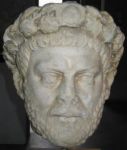
Gaius Aurelius Valerius Diocletianus
236-316 AD
During the rule of the Roman emperor Diocletian (284-305), a decree was issued targeting all Christians as enemies of the state. The story of this decree is intriguing and stands as a testimony to the veracity of Christ’s words and to the fact that the seven letters to the churches are prophetic.
According to the historical record, Diocletian was attending a solemn sacrifice when he was informed by those officiating the ceremony, that they could not be certain in their prognostications. The emperor then sought to find the reason for the problem from the god Apollo. The answer came back to him from the priests: the Christians were the source of the difficulty.
Upon hearing this, Diocletian issued an edict against all Christians in 303 AD. This launched a period of intense persecution that lasted exactly ten years. During this time, the emperor ordered the destruction of church meeting halls and the arrest of Christian clergymen. He also directed massive scripture burnings. It is true that God’s people had suffered intermittent persecution since its earliest years, but this was different. Here, Christianity in any form was treated with brazen hostility. To practice it made one the target of the state—with little chance of receiving mercy.
Then, in 313 AD, exactly ten years later, Emperors Constantine I and Licinius, issued the Edict of Toleration in Milan—suddenly ending the persecution of Christians in both the east and western parts of the empire. So complete was this change in Rome’s opposition to faith in Christ, that Christianity actually became the official religion of the empire. Mr. Ogwyn characterized it this way.
After almost three centuries of on-again, off-again persecution by the Roman government, the Edict of Toleration was issued at Milan in 313AD. Soon after, Christianity went from simply being officially tolerated by the Roman Empire, to actually becoming the official state religion of the empire. (God’s Church Through the Ages)
Although Rome embraced a false Christianity, persecution on God’s people also abated by royal decree—thus ending ten years of unremitting hostilities against them. Equally as important is what this means to the issue of church eras.
Compelling Evidence for Eras
At this point it is important to consider some critical facts concerning the ten years of tribulation the church suffered during this period, and how these facts support the case in favor of church ears. First and foremost is the fact that this persecution did not occur during the time John wrote the book of Revelation. There is simply no record of it. Therefore, the reference to ten days of persecution had to pertain to a church other than one existing during the first century.
Secondly, it defies all logic for persecution of any magnitude to take place in one city on this mail route and not touch neighboring congregations. Furthermore, even if such an unlikely scenario could take place it still presents a problem. The proximity of other congregations would have made flight from Smyrna very doable. For example: the city of Ephesus was only thirty five miles to its south, while Pergamos was but forty miles to the north. Had this letter been written exclusively to the Smyrna church existing in the John’s time, then anyone experiencing persecution would simply follow Christ’s instruction—“If they persecute you in one city, flee to the next” (Mt. 10:23). In other words, the small church in Smyrna would have moved to Ephesus or Pergamos, where no such persecution is mentioned. However, this did not happen.
The testimony of history proves that the prediction of Smyrna having tribulation for ten days was undeniably directed to a church that would exist two hundred years after the apostle John wrote Revelation. It was then that REAL persecution came upon God’s people living throughout the Roman Empire. They would suffer horribly for ten excruciating years, but eventually the tribulation would stop—at least for awhile. However, the remarkable story of God’s true church would continue to play out and is picked up in a letter to the church at Pergamos.
The Third Era
Compelling Evidence for Eras
The Church of Pergamos
"Lifted Up High"
450-1050 AD
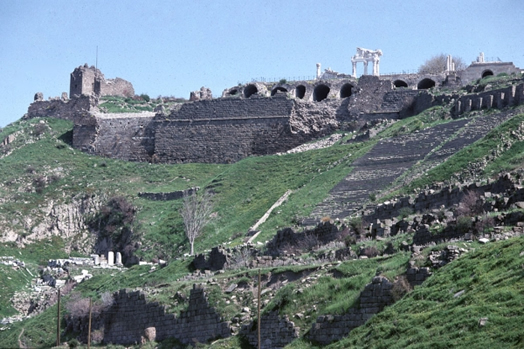
Ruins of Pergamos
The third congregation identified among the seven letters in Revelation was Pergamos. This city was located fifteen miles inland and about seventy five miles north of Ephesus When addressing this church, Christ says the following.
To the angel of the church in Pergamos write; These things saith he which hath the sharp sword with two edges; I know thy works and where thou dwellest, [even] where Satan's seat [is]: and thou holdest fast my name, and hast not denied my faith, even in those days wherein Antipas [was] my faithful martyr, who was slain among you, where Satan dwelleth. But I have a few things against thee, because thou hast there them that hold the doctrine of Balaam, who taught Balac to cast a stumbling block before the children of Israel, to eat things sacrificed unto idols, and to commit fornication. So hast thou also them that hold the doctrine of the Nicolaitans, which thing I hate. He that hath an ear, let him hear what the Spirit saith unto the churches; To him that overcometh will I give to eat of the hidden manna, and will give him a white stone, and in the stone a new name written, which no man knoweth saving he that receiveth it (Revelation 2:12-17).
Pergamos means “fortified” and was undoubtedly named so because of its location and construction. The city was built on a steep hillside and was terraced to accommodate the slope. When addressing this congregation Christ indicates that they dwell in “Satan’s seat.” This was likely a reference to the fact that the original city was the seat of the Roman government in Asia. Mr. Ogwyn writes:
Pergamum was a center of the ancient Babylonian mystery religion. In 133BC, Attalus III, the last "god-king" of Pergamum, died and in his will bequeathed his kingdom and his title, Pontifex Maximus ("Supreme Bridge-builder" between man and God), to the Romans. The Roman rulers took the title and held it until Emperor Gratian bestowed it on Pope Damascus in 378AD. The Catholic popes continue to use that title to this day. Also, historically, the term "Satan’s seat" alludes back to Nimrod’s ancient kingdom, which in distant antiquity included Armenia and the upper Euphrates (Genesis 10). The Pergamos Church—the Paulicians, geographically relocated to that same area after Constantine enforced Sunday keeping on the Roman Empire. (God’s Church Through the Ages)
The Paulicians
History records that this church era coincides with a people called Paulicians. In his book The History of the Christian Church, George Fisher wrote:
While the Christian world, as it has been the fashion to call it, was thus sunk into an awful state of superstition—at a moment when darkness seemed to cover the earth, and a gross darkness of the people—it is pleasing to contemplate a ray of celestial light darting across the gloom. About the year 650, a new sect arose in the east, under the name of Paulicians, which is justly entitled to our attention.
There are some who believe that the name Paulician came from one of their earliest leaders. However, others, including Edward Gibbon, taught that the name came from the fact that they believed themselves to be followers of Paul.

Edward Gibbon
1737-1794
The name of the Paulicians is derived, by their enemies, from some unknown and domestic teacher, but I am confident that they glorified in their affinity to the apostle of the Gentiles (The Decline and Fall of the Roman Empire, pp 57-63).
It is clear that the Paulicians were genuine descendents of the original apostolic church founded on the day of Pentecost 31 AD. An early leader of this community of believers, Constantine of Mananali (620-681), taught against the trinity, crosses, baptism by sprinkling, and pagan holidays. He also taught that there was no such thing as the apostolic succession of Popes, and hence he was considered to be against the Pope. It is believed by many that the term “Antipas” who was said to be God’s faithful Martyr (Rev. 2:13) actually means “antipope” and is a reference to Constantine, who would give his life for the faith.
The Murder of Constantine
The Roman church took great issue with the Paulicians and their leader, Constantine. To remedy this problem they dispatched Byzantine soldiers under the command of an officer named Simon, to seek out and murder him. It is said that after finding the Paulicians, Simon threatened to begin to kill them one at a time until they confessed who their leader was. Finally, one of their ranks betrayed Constantine, and Simon put this faithful leader to martyr’s death. However, Simon was so impressed with the people, and their leader’s faith, bravery, and humble attitude in death, that he began to study with them. He later became converted, and eventually became a successor to Constantine. Just three years later in 687, Simon would also be martyred.
The Key of Truth
In 1828 a manuscript of an ancient book belonging to the Paulicians was discovered in Armenia. The work was entitled The Key of Truth. Around 1900 Fred Coneybear translated it into english. Dr. Coneybear wrote that the Paulicians kept the commandments, including the Sabbath and the holy days.
The sabbath was perhaps kept and there were no special Sunday observances. . . . Wednesday and Friday were not kept as fast days. [and] of the modern Christmas . . . and other feasts connected with the life of Jesus prior to his thirtieth year, this phase of the church knew nothing. The general impression which the study of it leaves on us is that in it we have before us a form of the church not very remote from the primitive Jewish Christianity of Palestine.
In his introduction to The Key of Truth, Coneybear identified the Paulicians as "Quartodecimans" because of their practice of keeping the Passover on the fourteenth day of Nisan, the first month of the Hebrew calendar.
We also know from a notice preserved in Ananias of Shirak that the Pauliani, who were the same people at an earlier date, were Quartodecimans, and kept Easter in the primitive manner at the Jewish date. John of Otzun’s language perhaps implies that the old believers in Armenia during the seventh century were Quartodecimans, as we should expect them to be" (Coneybeare, intro., clii).
It is clear that these people did not deny Christ’s name. However, as Jesus had said in the letter to the church at Pergamos, some of them held to the doctrine of Balaam. Balaam was unable to curse Israel, and he finally realized that he could cause them to compromise by mixing with the heathen around them. By this, Balaam could cause God to bring a curse on them Himself (Numbers 22 & 23).
The Paulicians eventually fell prey to the same sort of compromise. Some began to conform to the practices of the Roman church. To avoid persecution, some christened their children. They even attended mass to avoid detection, fulfilling Christ’s words that they participated in spiritual fornication.
According to the words of our Savior, this Church was infected with the Nicoliatian heresy. As was mentioned earlier, this belief emerged during the first era of the church and is mentioned in Christ's letter to the church at Ephesus. The Nicoliatians believed that the mind was spiritual, and that only knowledge and matters of the mind were important. In this way, the people were lured into believing that they could compromise on doctrine. They could perform Roman Catholic practices, and it would not be sin to them because in their minds they knew the truth.
In the 8th and 9th centuries, the Paulicians were forced to resettle in the Balkans, where they became known as Bogomils. By this later date, they had compromised greatly. Mr Ogwyn describes the close of this era of God's church by describing the migration Bogomils to the west during the new millennium.
In the tenth and eleventh centuries, many Bogomils spread westward and settled in Serbia. Later, large numbers took refuge in Bosnia by the end of the twelfth century. These Bogomils were "only one version of a group of related heretical sects that flourished across Asia Minor and southern Europe during the Middle Ages under a variety of names, the best-known being the Patarenes, Cathars and Albigensians" (Encyclopedia Britannica, 15th ed., vol. 29, p. 1,098). They were condemned as heretics due to their belief that "the world is governed by two principles, good and evil, and human affairs are shaped by the conflict between them; the whole visible world is given over to Satan" (Encyclopedia Britannica, p. 1,098). From their Balkan base, the Bogomils’ influence, initially fostered by a merchant’s trading network, extended into Piedmont in Italy and also southern France. By the time the Ottoman Turks assumed power in Bosnia, the seeds of the Truth had spread to the Piedmont, Provencal and Alpine areas of Europe. (God’s Church Through the Ages)
|
The Fourth Era
The Church of Thyatira
"Sacrifice"
1050 - Present
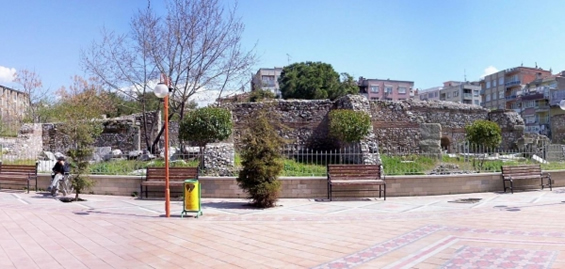
Mound with ruins of Thyatira in Akhisar,
Manisa Province, Turkey
The fourth letter written to the churches in Asia is addressed to Thyatira. This era of God’s church is one engaged in a struggle between honoring their Savior and compromising His truth by capitulating with a great false church, called Jezebel. Notice how Christ introduces His letter to them.
Unto the angel of the church in Thyatira write; these things saith the son of God, who hath his eyes like unto a flame of fire, and his feet [are] like fine brass; I know thy works, and charity, and service, and faith, and thy patience, and thy works; and the last [to be] more than the first. (Revelation 2:18-20)
The letter to Thyatira is also reflected in the historical record. During the middle ages God’s Church migrated to Europe. There it spread across the Alps, through France, and into Italy. Many individuals provided leadership to these scattered people, encouraging them to hold fast to the truth. One such man, Peter Waldo, stands out among them.
Waldo was a successful merchant who forsook a life of affluence to serve God and His people. He gave much of his wealth to the poor, using the rest to translate the scriptures into the common language. Many were converted by his work as he taught God's truth throughout France, Italy, on up into Hungary, and eventually even into Russia. These people were often called Vaudois, Insabbati, Albigenses, and latter, Waldensians. Historian, Peter Allix (1641 - 1717) wrote of them, saying:
[They] declare themselves to be the apostles' successors, to have apostolic authority, and the keys of binding and loosing. They hold the church of Rome to be the whore of Babylon. (Ecclesiastical History of Ancient Churches of Piedmont)
The Encyclopedia Britannica makes an interesting observation regarding Waldo and the gospel he preached. Unlike many who preach a gospel about Christ, Waldo preached the gospel of Christ.
"Like St. Francis [of Assisi], Waldo adopted a life of poverty that he might be free to preach, but with this difference that the Waldenses preached the doctrine of Christ while the Franciscans preached the person of Christ." (Encyclopedia Britannica, 11th ed.)
When describing the Waldenses, John Ogwyn explains their loyalty to God's Sabbath law by quoting respected scholars of the middle ages as well as the prominent 19th century historian William Jones.
One of the names by which they were most anciently known was that of Sabbatati! In his 1873 work, History of the Sabbath, historian J. N. Andrews quotes from an earlier work by Swiss-Calvinist historian [Melchior] Goldastus (1576-1635) written about 1600. Speaking of the Waldenses, Goldastus wrote: "Insabbatati [they were called] not because they were circumcised, but because they kept the Jewish Sabbath" (Andrews, p. 410). Dr. Andrews further refers to the testimony of Archbishop Ussher (1581–1656) who acknowledged "that many understood that they [the names Sabbatati or Insabbatati] were given to them [Waldenses] because they worshipped on the Jewish Sabbath" (p. 410). Clearly even noted Protestant scholars at the end of the Middle Ages were willing to acknowledge that many Waldenses had observed the seventh-day Sabbath.
In his 1845 work, The History of the Christian Church, William Jones wrote:
"Investigators made a report to Louis XII [reigned 1498–1516], king of France, that they had visited all the parishes where the Waldenses dwelt. They had inspected all their places of worship… but they found no images, no sign of the ordinances belonging to the mass, nor any of the sacraments of the Roman church.… They kept the Sabbath day, they observed the ordinance of baptism according to the primitive church, instructed their children in the articles of the Christian faith and the commandments of God.…
The Waldenses could say a great part of the Old and New Testaments by heart. They despise the sayings and expositions of holy men [Roman Catholic Church fathers], and they only plead for the test of Scripture.… The traditions of the [Roman] church are no better than the traditions of the Pharisees, and that greater stress is laid [by Rome] on the observance of human tradition than on the keeping of the law of God. They despise the Feast of Easter, and all other Roman festivals of Christ and the saints" (A Handbook of Church History, pp. 234, 236–237). (God’s Church Through the Ages)
Waldo made Lyons, France, the center of his preaching from 1161 until 1180. Then, because of persecution, he relocated to northern Italy. From about 1210 until his death seven years later, Waldo spent his time preaching in Bohemia and Germany.
The persecution that necessitated Waldo's migration was brought on by the Catholic church which applied great pressure on any who would embrace a faith that went contrary to their doctrine. The famous Dutch theologian, Philipp van Limborch (1633-1712) described the gravity of persecution applied by the church of Rome.
It was the entire study and endeavour of the popes, to crush, in its infancy, every doctrine that any way opposed their exorbitant power. In the year 1163, at the synod of Tours, all the bishops and priests in the country of Tholouse, were commanded 'to take care, and to forbid, under the pain of excommunication, every person from presuming to give reception, or the least assistance to the followers of this heresy, which first began in the country of Tholouse, whenever they shall be discovered. Neither were they to have any dealings with them in buying or selling; that by being thus deprived of the common assistances of life, they might be compelled to repent of the evil of their way. Whosoever shall dare to contravene this order, let them be excommunicated, as a partner with them in their guilt. As many of them as can be found, let them be imprisoned by the Catholic princes, and punished with the forfeiture of all their substance.
This attempt to stamp out people like the Waldenses came from Pope Alexander III (1159-1181). Alexander issued the edict at the Council of Tours mentioned above, In it he prescribed the treatment of those considered to be heretics. Notice the sobering words of this edict.
Whereas a damnable heresy has for some time lifted its head in the parts about Toulouse, and already spread infection through Gascony and other provinces, concealing itself like a serpent in its folds; as soon as its followers shall have been discovered, let no man afford them refuge on his estates; neither let there be any communication with them in buying and selling; so that, being deprived of the solace of human conversation they may be compelled to return from error to wisdom. (History of the Christian Church, 1879, Mosheim)
In his Ecclesiastical History Dr, Allix quoted a Roman Catholic author who characterized the Waldensians as as enemies of the papacy and that they kept God's law, including the Sabbath.
They say that blessed Pope Sylvester was the Antichrist, of whom mention is made in the Epistles of St. Paul, as being the son of perdition, who extols himself above everything that is called God: for, from that time, they say, the Church perished. . . . That the Law of Moses is to be kept according to the letter, and that the keeping of the Sabbath, circumcision, and other legal observances, ought to take place (Ancient Churches of Piedmont p. 154, edition of 1690, Oxford: 1821).
Consorting with Jezebel
When addressing the church at Thyatira, Christ identifies a serious flaw in them. He speaks of their capitulation with a great false church, called Jezebel. Notice what He says.
Notwithstanding I have a few things against thee, because thou sufferest that woman Jezebel, which calleth herself a prophetess, to teach and to seduce my servants to commit fornication, and to eat things sacrificed unto idols. And I gave her space to repent of her fornication; and she repented not. Behold, I will cast her into a bed, and them that commit adultery with her into great tribulation, except they repent of their deeds… (Rev. 2:20-22)
Under enormous pressure from the Catholic church and Rome’s powerful armies, the Waldenses eventually began to compromise. At first, they practiced the truth in secret, hiding in caves or in the homes of members. As their lives became more unbearable, some would allow Catholic priests to christen their children and even participated in Catholic ceremonies, such as communion, so that they would not stand out as being different. By such practices they committed spiritual fornication.
However, ultimately they would suffer tribulation just as Christ had said. This took place at the time of the great inquisition during the middle ages. During this time, Pope Innocent III (1160-1216) wrote the following instruction to his bishops:
Therefore by this present apostolical writing we give you a strict command that, by whatever means you can, you destroy all these heresies and expel from your diocese all who are polluted with them. You shall exercise the rigor of the ecclesiastical power against them and all those who have made themselves suspected by associating with them. They may not appeal from your judgments, and if necessary, you may cause the princes and people to suppress them with the sword (A Source Book for Mediaeval History, Oliver J. Thatcher and E. H. McNeal, p. 210. New York: Charles Scribner's Sons, 1905).
History records that the Waldenses would slowly disappear from centers of population and would seek took refuge in the Alps. According to the Encyclopedia Britannica they were called "Vaudois" and were difficult targets of persecution.
There, in the recesses of Piedmont… a settlement of the Waldensians was made who gave their name to these valleys of Vaudois.… At times attempts were made to suppress the sect of the Vaudois, but the nature of the country which they inhabited, their obscurity and their isolation made the difficulties of their suppression greater than the advantages to be gained from it." (Encyclopedia Britannica, 11th ed., "Waldenses")
When writing about this period, John Ogwyn described how, as the close of the fifteenth approached, most of the remnant of the Waldenses became weary of persecution and sought to compromise rather than suffer.
In 1487, Pope Innocent VIII issued a bull calling for their extermination and a serious attack was made on their stronghold. A fog settling over and encircling the Catholic armies saved the Waldenses from total destruction. However, most were simply worn out and had lapsed into a spirit of compromise. When the Reformation began a few years later, the Waldensian leadership sent emissaries to the Lutheran church. "Thus," as the Encyclopedia Britannica writes, "the Vaudois ceased to be relics of the past, and became absorbed in the general movement of Protestantism." (God’s Church Through the Ages)
A Faithful Remnant
Although total apostasy swallowed up most of the Waldenses by the end of the 1500s, God preserved a faithful remnant. Individuals who were the fruit of the last seven years of Waldo’s ministry had been converted in Bohemia and Germany in the thirteenth century. In remote areas of the Carpathian Mountains, small groups survived—in fact a faithful remnant has survived in isolation in those areas down to modern times. This too is reflected in Christ's promise that Thyatira would exist when He return. (Rev. 2:24–25)
An Ironic Symbol
It is interesting to note that some of the European Waldenses displayed an emblem reflecting their work. Ironically, and perhaps unbeknownst to them. their logo actually displayed the age they were in. It included a single candlestick with seven stars in a half circle at the top. The center (fourth) star pointed down to the candlestick. Surrounding the logo were the words "Lux Lucet In Tenebris," which in English means, “A Light Shines in the Darkness.”
The Waldenesian Emblem
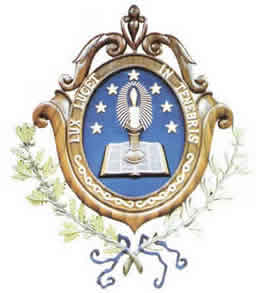
The Fifth Era
The Church of Sardis
"Remnant"
1600 - Present
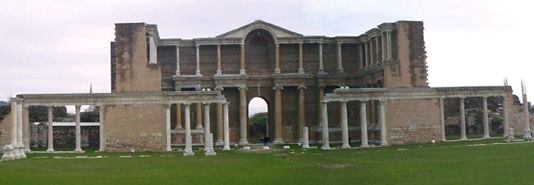
Bath-Gymnasium complex at Sardis (c. 211 A.D.)
The fifth letter to the churches in Asia is addressed to Sardis. Church is Sardis. To this Church, the apostle John was told to write:
Unto the angel of the church in Sardis write; these things saith he that hath the seven spirits of God, and the seven stars; I know thy works, that thou hast a name that thou livest, and art dead. (Revelation 3:1)
By the end of the sixteenth century, numerous groups emerged from the Waldenses and began growing in parts of Central Europe and Britain. They were labeled by outsiders as "Sabbatarian Anabaptists." They were termed Sabbatarian because they taught and observed the seventh-day Sabbath. They were called Anabaptists, meaning "re-baptizers," because they refused to accept infant baptism. They taught that baptism was only for adults who had come to believe the Gospel and had repented of their sins (cf. Acts 2:38).
Heroes of the Faith
When addressing the church of Sardis Christ exhorted them to "hold fast" and even spoke of a few that had not compromised their faith.
When addressing the church of Sardis Christ exhorted them to "hold fast" and even spoke of a few that had not compromised their faith.
Be watchful, and strengthen the things which remain, that are ready to die: for I have not found thy works perfect before God. Remember therefore how thou hast received and heard, and hold fast, and repent. If therefore thou shalt not watch, I will come on thee as a thief, and thou shalt not know what hour I will come upon thee. Thou hast a few names even in Sardis which have not defiled their garments; and they shall walk with me in white: for they are worthy. (Rev. 3:2-4)
Three men that stand out as faithful among the Anabaptists are Oswald Glaidt, Andreas Fischer and Andreas Eossi. These courageous servants taught primarily in eastern Europe and were advocates of God's law. Among other things they stressed obedience to the Sabbath and holy days as well as repudiated the doctrine of the trinity. Glaidt and Fischer actually wrote books in defense of the Sabbath. History records that in response to those who accused him of teaching that salvation is earned by works, Glaidt responded:
"The moral law says, ‘Do not murder,’ yet nobody would argue seriously that this is no longer in effect, nor would anyone argue that simply to refrain from murder is an attempt to achieve salvation on the basis of ‘works.’" (Daniel Liechty, Sabbatarianism in the Sixteenth Century, p. 31)
Because of his steadfast conviction, Glaidt was executed in Vienna in 1546. Shortly prior to his death he told his accusers:
"Even if you drown me, I will not deny God and His Truth. Christ died for me and I will continue to follow Him and would die for His Truth before I would give it up." (Daniel Liechty, Sabbatarianism in the Sixteenth Century, p. 35)
The Sabbath Debate in England
In the early 1600s the debate over whether or not the Biblical Sabbath was still in effect was intensifying in England. However the persecution on those who taught that God's Sabbath law was to be honored was fierce. In his book, The Incredible History of God’s True Church, Ivor Fletcher recounts an event in 1661 in which Mr. John James was preaching a sermon on the Sabbath in Bull-Stake Alley, London, and was forcibly dragged from the church. After his trial, he was sentenced to be hung, then drawn and quartered. Notice the chronicle of this event.
John James was arrested and brought to trial, found guilty under the new law against non-conformity. He was sentenced to the barbaric fate of being hung, drawn and quartered.
It was said that “This awful fate did not dismay him in the least. He calmly said, ‘Blessed be God, Whom man condemneth, God justifieth!’”
James was held in high esteem by many, and whilst in prison under sentence of death, several people of rank and distinction visited him and offered to use their influence to secure his pardon. His wife sent two petitions to the King, but all these moves failed to save him.
In his final words to the court he simply asked them to read the following scriptures: Jer. 26:14-15 and Psa. 116:15. In keeping with the gruesome custom of the time, after his execution his heart was taken out and burned, the four quarters of his body fixed to the gates of the city and his head set up on a pole in Whitechapel opposite to the alley in which his meeting-house stood. Such was the horrible price that some were prepared to pay for obedience to God in seventeenth century England. (The Incredible History of God’s True Church, p 176)
God's Church in America
One of the most significant men in this era of God's church was Stephen Mumford. He and his wife left England and settled in Rhode Island in 1664. John Ogwyn explains that shortly after that the Church of God in England had compromised their faith greatly.
By the early 1700s the Church of God in England was virtually dead. Most of the ministers at that time, in addition to preaching on the Sabbath, were now pastoring churches on Sunday to make extra money. Compromise took its toll. (God’s Church Through the Ages)
Upon arriving in Rhode Island, the Mumfords began to fellowship with a Baptist group in Newport. However, they were very outspoken about keeping God's true Sabbath. Their first convert was a man named Tacy Hubbard. Shortly afterward, her husband Samuel joined her. In 1671 the first Sabbath-keeping church in America officially began. It had seven members. William Hiscox was its first pastor and served in that position until his death in 1704.
Naming the Church
In the earliest days, no special thought was given to an official church name. Congregations simply referred to themselves as "the Church of Christ which is at Newport" or "the Church of God living in Piscataway." Most members called it "the Church." Outsiders referred to them as Sabbatarians or Sabbatarian Baptists. When the church in Newport received an official state charter in 1819 it was registered under the name "Seventh-Day Baptist Church of Christ."
A Number of Churches were founded over time, eventually calling themselves the Seventh Day Church of God. In 1906, A. J. Dugger became the editor of a fledgling magazine called The Bible Advocate. This publication is still in existence today.
This era of God's church, although generally committed to keeping the Sabbath, and the laws of clean and unclean meats, compromised on important biblical truths. Many would eventually embrace the doctrine of the trinity as well as neglect observing God's holy days. As a result, this era of the Church was never able to do a large work of watching and preaching the gospel as a witness. Although they retained the name Church of God, they left little in the way of a mark on the world.
The Sixth Era
The Church of Philadelphia
"Brotherly Love"
1933 - Present

Ruins of Philadelphia in Asia Minor
When reading each letter to the churches is Asia something striking emerges in the one written to Philadelphia. When speaking to this congregation, Christ offers words of great consolation and hope. He characterizes them as steadfast in keeping His word and diligent in doing His work. Furthermore, this is the one church that Christ doesn't chastise. At no time does He say, "I have something against thee." Clearly there is something very special about this end-time church that distinguishes it in God's eyes. Notice Christ's words.
And to the angel of the church in Philadelphia write; These things saith he that is holy, he that is true, he that hath the key of David, he that openeth, and no man shutteth; and shutteth, and no man openeth; I know thy works: behold, I have set before thee an open door, and no man can shut it: for thou hast a little strength, and hast kept my word, and hast not denied my name. (Rev. 3: 7-8)
An Explosion of Truth
At the beginning of the twentieth century the church of God was a small and scattered community. Some have estimated that there may have been less than one thousand faithful worldwide. But all that was about to change. God's truth was going to be proclaimed with a clarity that had not been heard since the days of the original apostles. Furthermore, although His church would have relatively little strength, compared to "mainstream" Christianity, it would POWERFULLY proclaim the gospel of God's kingdom.
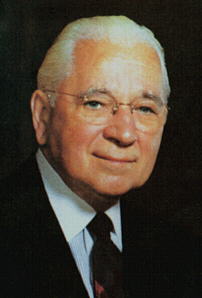
Mr. Herbert W Armstrong
1892 - 1986
During the first half of the twentieth century, Herbert W. Armstrong began to preach an extraordinary gospel message on radio. He would later produce a telecast that would blanket the United States as well as publish several magazines with a circulation measuring in the millions. Mr. Armstrong taught that although salvation is a gift, obedience to God is an essential part of the Christian walk. He also taught that God’s commandments represent a way of giving, while man was consumed with the way of "get." Under his leadership, God’s truth would ultimately be proclaimed around the world. However, what characterized this work more than anything was its zeal and willingness to obey God, regardless of the consequences.
Small Beginnings and Big Dreams
In 1933, Mr. Armstrong began using personal campaigns and radio broadcasts to preach the gospel. For this reason the church was first called the Radio Church of God. One year later he published the first issue of the Plain Truth magazine. At this time something miraculous seemed to be taking place. Doors were being opened and the work was growing at an amazing rate.
By the late 1960s the Worldwide Church of God had truly become a worldwide endeavor. In the years that followed, this relatively small community of faithful would be the largest consumer of religious television and radio broadcast time in the United States. It would ultimately publish over 8,000,000 copies of the Plain Truth Magazines, in seven different languages, every single month.
During his years of service, Mr. Armstrong traveled the globe as an ambassador of goodwill. He visited over 70 countries and met with some of the world’s leading dignitaries. His influence was truly extraordinary. He was honored by the heads of state in countries such as Japan, Israel, and Egypt and his impact on the millions of lives he touched is undeniable.
When he died, Herbert W. Armstrong left a remarkable legacy. He was the founder and chancellor of three colleges, as well as the author of numerous books and virtually hundreds of articles and booklets. Additionally, he was the editor of a magazine with a monthly circulation of over 8 million and was the voice of several hundred radio and television broadcasts.
Perhaps the greatest legacy Mr. Armstrong left was a work that continues to this very day. That work is performed by thousands of faithful who steadfastly held on to the truth he restored. Those faithful servants, although scattered, continue to diligently proclaim the gospel of God’s kingdom as well as nurture God’s church with His truth.
In Transition
When speaking to the church at Philadelphia Christ revealed that they would encounter enemies who would claim to be God's servants, but in fact were not. He also promised that He would vindicate His true servants and His people. Notice what He says.
Behold, I will make them of the synagogue of Satan, which say they are Jews, and are not, but do lie; behold, I will make them to come and worship before thy feet, and to know that I have loved thee. (Rev. 3:9)
When Herbert Armstrong died in 1986, his successors repudiated everything he had taught and replaced that teaching with doctrines that were never embraced during the early days of the New Testament Church. This new generation of leaders claimed to be "spiritual Jews," but abandoned the TRUTH that had been restored by Mr. Armstrong. Consumed by their newly discovered power and an inflated ego bent toward intellectual vanity, these new "leaders" embraced the doctrine of the trinity and declared that observance of the Sabbath and Holy Days was "optional." These men, and now women, also promoted the doctrines of the immortality of the soul, that the law was done away at the cross, and that the observance of holidays such as Christmas and Easter are positive expressions of faith despite having their origins in paganism. This was all done to conform to what church leadership called "normative Christianity." Additionally, those who refused to embrace the new teachings of the church were ordered to stay silent or face being disfellowshipped. Many took action and voluntarily left this now Bible rejecting organization in accordance with the scriptures (1 Tim. 6:5, 2 Tim. 3:5). Sadly, many stayed.
The apostle Paul once warned that at the time of the end, a great apostasy would take place within the Church (2Thes. 2:3). Mr. Armstrong’s successors have unquestionably fulfilled this prophecy.
|
An Immutable Promise
One of the great promises Christ makes to the church at Philadelphia is that He will protect them from destruction that will come upon the earth in the last days. This great tribulation, which is inflicted by Satan the devil, will be unlike anything the earth has ever seen, or, ever will see (Mt 24: 21-22, see also: Jer. 30:7). However, because God's beloved Philadelphians have continued in His truth, He will remember them, both in this life and in the resurrection. Here is what the Messiah says.
Because thou hast kept the word of my patience, I also will keep thee from the hour of temptation, which shall come upon all the world, to try them that dwell upon the earth. Behold, I come quickly: hold that fast which thou hast, that no man take thy crown. Him that overcometh will I make a pillar in the temple of my God, and he shall go no more out: and I will write upon him the name of my God, and the name of the city of my God, which is new Jerusalem, which cometh down out of heaven from my God: and I will write upon him my new name. (Rev. 3: 10-12)
The Seeds of a New Era
Shortly after the death of Mr. Armstrong and the introduction of false teachings within the church, God’s people were again scattered, with numerous fellowships (splinter groups) arising. For the most part, these fellowships share a common theology. However, they are vastly different with respect to their zeal for God and His work. Also emerging within these churches is a highly judgmental attitude toward each other. This attitude is reflected in some groups believing they are superior to others and all believing that somehow they are God’s favorites. Tragically, this spirit will form the foundation of the seventh, and final era of God's church, Laodicea.
The Seventh Era
The Church of Laodicea
"The People Judge"
Present Age
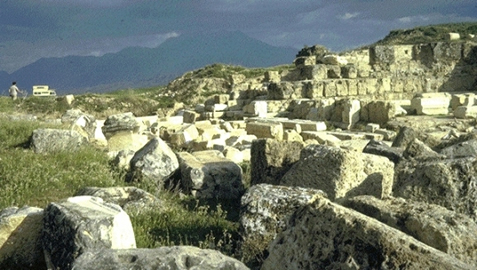
Ruins of Laodicea
The seventh and final letter written to the churches in Asia is addressed to Laodicea and stands in sharp contrast to that given to Philadelphia. While Philadelphia is commended for keeping God's word, Laodicea is rebuked for its arrogance and lack of zeal. Laodicea thinks of itself as rich and self-sufficient, while Christ calls them "wretched and miserable. Notice the sobering warning of His message.
Unto the angel of the church of the Laodiceans write; these things saith the amen, the faithful and true witness, the beginning of the creation of God; I know thy works, that thou art neither cold nor hot: I would thou wert cold or hot. So then because thou art lukewarm, and neither cold nor hot, I will spue thee out of my mouth. Because thou sayest, I am rich, and increased with goods, and have need of nothing; and knowest not that thou art wretched, and miserable, and poor, and blind, and naked: (Revelation 3:14-17).
The Last Generation
Those who rejected the protestant changes adopted by the leadership of the Worldwide Church of God, ultimately withdrew from that once dynamic, God inspired community of faith. However, even though they did leave, many absorbed the spirit brought in as a result of the apostasy. Others felt a sense of resentment because the ministers that didn't buy into the apostasy refused to boldly stand up and fight against it. Many were stunned and numbed by what God allowed to occur. As a result they lost much of their zeal for doing God’s work. Furthermore, a general tendency of mistrust and judgment developed toward the ministry, whose job it was to protect the brethren, but who seemed more interested in protecting themselves. As a result, people began to look more to their own judgment when it came to what should be taught and what should be believed. In other words, they became the evaluators of true doctrine. It is ironic that the name "Laodicea" means, "The people judge."
As these believers exited the apostate Church, they formed scores of new, independent church organizations. As a result there was often a sense of liberation, a kind of euphoria about what they were doing as a church. However, the sense of power felt by the many organizations that sprung also gave rise to a plethora of new doctrines and pet theories--among them: the nature of God, the nature of Christ, the nature of the spirit realm, the legitimacy of the Hebrew calendar, God's name, the "true" identity of Lucifer, and the proper day to observe the Passover, just to name a few. Additionally, almost all of these groups cultivated a strong opinion regarding church (hierarchical) government. Sadly, those who favor it rule as tyrants, while those who oppose have raised church politics to a new level.
Finally, the church became half-hearted toward Christ’s commission to preach the gospel as a witness. It became lukewarm toward warning the world of the calamity that is to come because of its defiance to God and His law. Tragically, this is the state God's church finds itself in today. And it is precisely what Christ warned in His letter to Laodicea.
A Dangerous Future
Although God promises protection from tribulation to Philadelphia, He makes no such promise to Laodicea. On the contrary, their future is bleak. Notice Christ's words.
I counsel thee to buy of me gold tried in the fire, that thou mayest be rich; and white raiment, that thou mayest be clothed, and that the shame of thy nakedness do not appear; and anoint thine eyes with eyesalve, that thou mayest see. (Rev. 3:18)
This is a fate that no child of the true God wants to be the recipient of. When Christ speaks of the "shame of your nakedness," He is describing the ravages and humiliation of defeat in war. In the Old Testament He also explained that this would be the consequence if ancient Israel defied Him and His law. When establishing His covenant with them, God warned that one of the consequences of rebellion against Him would be that Israel would have to serve its enemies in nakedness (Dt. 28:48).
The twelfth chapter of Revelation describes a time in the future when some of God's people will be supernaturally protected from a desperate attempt by Satan to destroy them (Rev. 12:14-16). However, some will not receive His protection and become the object of Satan's wrath (Rev. 12:17). This is unquestionably Philadelphia and Laodicea.
A Final Thought
Throughout the past twenty centuries, certain patterns have emerged within God’s true Church. These patterns help identify who His servants are and the path they have taken. Consider seven prominent characteristics of God’s church down through the ages, all of which are described in seven letters.
- God’s church has always been small. Jesus Christ, Himself, referred to it as "a little flock."
- The church has repeatedly experienced great persecution, inflicted for the most part by those who claim to be God’s servants. This persecution has taken the form of unspeakable violence in which God’s people were tortured and even murdered for their belief. It has also taken the form of vicious verbal abuses in which God’s people have been characterized as "extremists" and "fanatics" while His Church has been labeled an "apostate cult." Jesus Christ warned that there would be persecution on His people and throughout the scriptures, the Church is exhorted to endure this persecution. (Mt. 10:16-39).
- God’s church down through the ages has striven to obey God’s law, including His Sabbath and Holy Days. At the very end of man’s rule on earth, God’s people are characterized as those who keep His commandments and have the testimony of Jesus Christ. (Rev. 12:17; 14:12)
- God’s Church has rejected pagan traditions which are always trying to creep into its teachings. (Mk. 7:7-9)
- God’s people have constantly fought against false teachers who emerge within their ranks. These fights have become so intense that God’s true servants have often been driven out of the very churches they founded. (1Jn. 4:1; 2Pe. 2:1; 3Jn. 9-10)
- God’s true church is repeatedly scattered but continues to survive. Jesus Christ declared that the gates of hell (the grave) would never prevail against His Church. (Mt. 16:18)
- God’s true church has proclaimed a gospel message as a witness and will continue proclaiming that gospel until the return of Jesus Christ. (Mt. 24:14)
Today, God’s church can be identified with three signs. It bears His name, it keeps His commandments, and it does His work. Despite relentless persecution from without as well as periods of great apostasy from within, God’s true church endures and will be in existence at the return of Jesus Christ.
This has been proclaimed by the witness of history for two thousand years. And that history is powerfully declared in seven prophetic letters delivered by seven angels to seven churches in Asia.
COMING SOON
Exhibit 5

